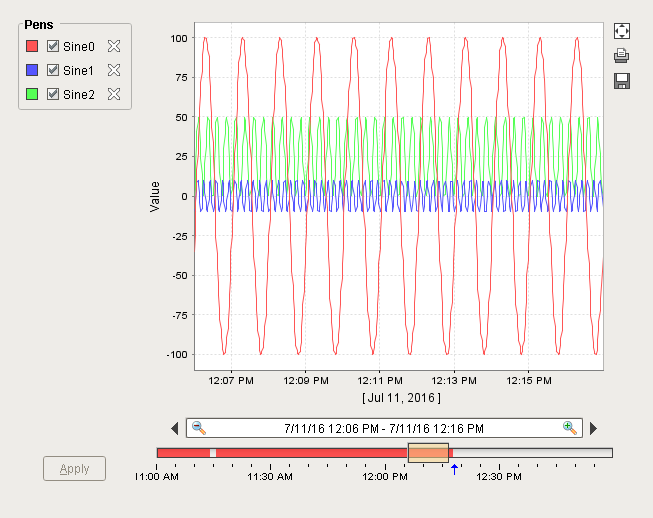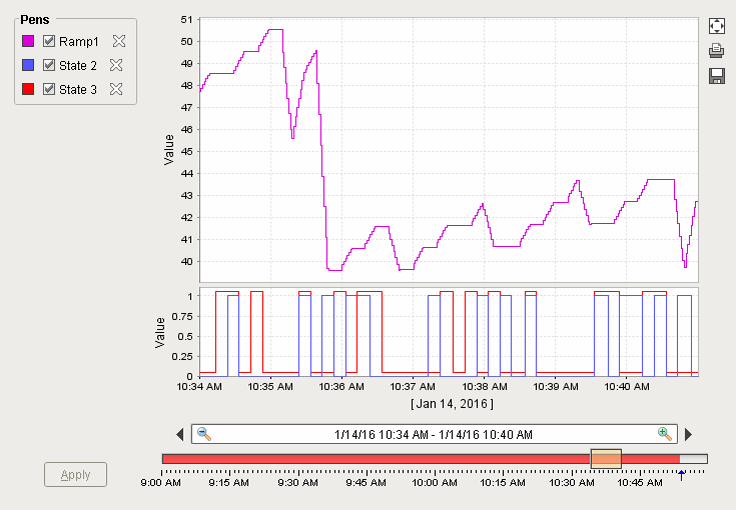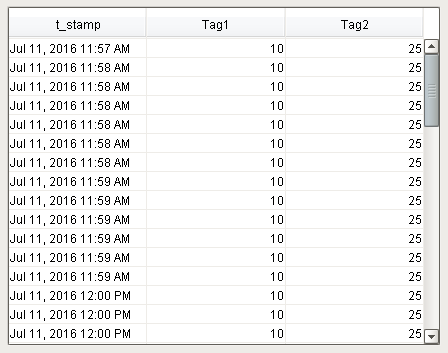Historian
Recording History
Ignition has two main approaches to recording historical data:
-
Tag Historian: Individual or groups of tags can be configured to record history based on scan class execution.
-
Transaction groups: Groups of OPC items that are recorded on an execution cycle. More information on Transaction Groups can be found in the Data Bridge (Transaction Groups) section.
What is the Tag Historian?
Tag Historian makes it easier that ever to store and use historical data. Simply by selecting a check box on a tag, historical data is stored in an efficient format in your SQL database. This data is then available for querying through scripting, historical bindings, and reporting. The available options for partitioning and deleting old data help to ensure the system stays properly maintained with minimal extra work. Also, you can drag-and-drop tags directly onto an Easy Chart component to create trends or onto a table to display historical values. Tags Historian's robust querying features provide you great flexibility in how you retrieve the stored data.
Historian Charts
Creating charts to display historical data or realtime data is a snap! The Easy Chart component allows you to make powerful, runtime-configurable time series charts from the Tag Historian data. Simply drag and drop history-enable tags onto a chart a chart to create chart pens and data trends. Your charts and graphs can include subplots, axes, digital offsets, and a moving average pen. You can quickly and easily turn your historical and realtime data into dynamic charts and graphs for your users.
To see all the chart options and features, refer to the section on Using the Easy Chart.


Historian Tables
Just like charts, creating tables using the Table component is just as easy! Drag and drop historian enabled tags onto a table component to display historical values in many different ways depending on how you customize your table. You can bring back the most recent history, a specific date range, fixed sample size, interval sample size, and more. To see all the table options and features, refer to the section on Tag Historian and Tables.

Tag Historian Querying
While the data is stored openly in the database, the format does not lend itself well to direct querying. Instead, Ignition offers a range of built-in querying options that are very powerful and flexible. In addition to the simple on-change querying, the system can perform advanced functions such as querying many tags from multiple providers, calculating their quality, interpolating their values, and coordinating their timestamps to provide fixed resolution returns.
Querying can be performed on tables and charts through the Historical Binding, and through scripting. You can also query tags from the Reporting Module.
Other Methods of Storing Historical Data
Data Bridge (Transaction Groups) perform a variety of tasks, one in particular, to store data historically. In their simplest form, transaction groups read values from the OPC addresses, and store them into a SQL database. There are four types of Transaction Groups; Standard, Block, Historical, and Stored Procedures. Each transaction group handles data a little differently.
-
Standard Group - is the most flexible, and can also write database values to OPC addresses or synchronize data changes between both the database and PLC. This allows you to create true realtime values tables in a database, and push values to a PLC.
-
Historical Group - can quickly store data from the plant floor into any kind of SQL database.
-
Block Group - transfers large amounts of data very efficiently.
-
Stored Procedures - uses PLC data as inputs and outputs from your existing stored procedures.
Data storage
As mentioned, the historical tag values pass through the store and forward engine before ultimately being stored in the database connection associated with the historian provider. The data is stored according to its datatype directly to a table in the SQL database, with its quality and a millisecond resolution timestamp. The data is only stored on-change, according to the value mode and deadband settings on each tag, thereby avoiding duplicate and unnecessary data storage. The storage of scan class execution statistics ensures the integrity of the data. While advanced users may change the table according to their database to be more efficient (for example, using a compressed engine), Ignition does not perform binary compression or encrypt the data in any way.
In This Section ...